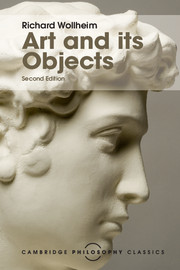Book contents
- Frontmatter
- Dedication
- Contents
- Preface to this edition
- Preface to the second edition
- The argument
- Art and its objects
- Supplementary essays
- 1 The Institutional theory of art
- 2 Are the criteria of identity for works of art aesthetically relevant?
- 3 A note on the physical object hypothesis
- 4 Criticism as retrieval
- 5 Seeing-as, seeing-in, and pictorial representation
- 6 Art and evaluation
- Bibliography
1 - The Institutional theory of art
from Supplementary essays
Published online by Cambridge University Press: 05 November 2015
- Frontmatter
- Dedication
- Contents
- Preface to this edition
- Preface to the second edition
- The argument
- Art and its objects
- Supplementary essays
- 1 The Institutional theory of art
- 2 Are the criteria of identity for works of art aesthetically relevant?
- 3 A note on the physical object hypothesis
- 4 Criticism as retrieval
- 5 Seeing-as, seeing-in, and pictorial representation
- 6 Art and evaluation
- Bibliography
Summary
By the Institutional theory of art I mean a view which offers a definition of art: the definition it offers purports to be non-circular, or, at least, not viciously circular: and it defines art by reference to what is said or done by persons or bodies of persons whose roles are social facts. Not everyone, indeed not everyone who professes the Institutional theory, would agree even with this summary of it, so it must be taken as in part stipulative.
In seeking to define art the Institutional theory offers more than just a method for picking out those things in the world which are or happen to be works of art. Indeed, whether it even offers such a method depends on whether the definition it provides can be used operationally, or is epistemically effective, but, if it is, then what is significant about the method is that it picks out works of art by those properties, and only those, which are essential to them. In this respect the Institutional theory is committed to an enterprise that is far more radical, also far more traditionalist, than, for instance, that which I consider in section 60 of the main text: and it is also just the enterprise that, over the past two decades or so, more sceptically inclined philosophers, often expressing an indebtedness to Wittgensteinian ideas, have declared not possible. The Institutional theory by proposing a definition of art promises a return to what it sees as mainstream aesthetics.
However, if the theory is ambitious in aim, it affects, or tends to affect, a certain modesty of scope. Most adherents of the Institutional theory claim to distinguish more than one sense of the term ‘art’, and the definition they offer is intended only for the primary or ‘classificatory’ sense. Used in this sense, ‘art’ assigns the thing to which it is applied to a certain class or category. But Institutionalists discern also an ‘evaluative’ sense of the term and sometimes an ‘honorific’ or ‘courtesy’ sense. Used in the evaluative sense, ‘art’ rates the thing to which it is applied high up amongst members of this class or category.
- Type
- Chapter
- Information
- Art and its Objects , pp. 105 - 111Publisher: Cambridge University PressPrint publication year: 2015



